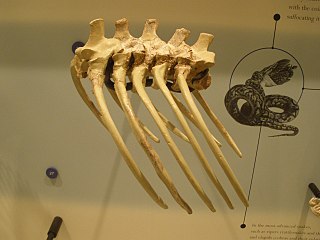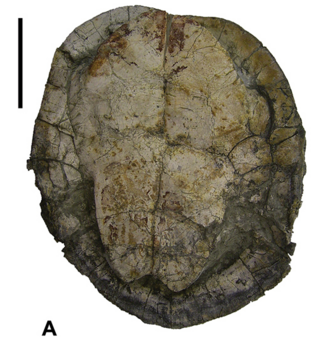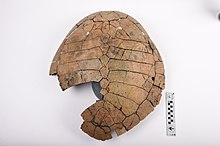
Chelidae is one of three living families of the turtle suborder Pleurodira, and are commonly called Austro-South American side-neck turtles. The family is distributed in Australia, New Guinea, parts of Indonesia, and throughout most of South America. It is a large family of turtles with a significant fossil history dating back to the Cretaceous. The family is entirely Gondwanan in origin, with no members found outside Gondwana, either in the present day or as a fossil.

Podocnemididae is a family of pleurodire (side-necked) turtles, once widely distributed. Most of its 20 genera and 30 species are now extinct. Seven of its eight surviving species are native to South America: the genus Peltocephalus, with only one species ; and the genus Podocnemis, with six living species of South American side-necked river turtles. There is also one genus native to Madagascar: Erymnochelys, the Madagascan big-headed turtle, whose single species E. madagascariensis.

Madtsoiidae is an extinct family of mostly Gondwanan snakes with a fossil record extending from early Cenomanian to late Pleistocene strata located in South America, Africa, India, Australia and Southern Europe. Madtsoiidae include very primitive snakes, which like extant boas and pythons would likely dispatch their prey by constriction. Genera include Madtsoia, one of the longest snakes known, at an estimated 10 metres (33 ft), and the Australian Wonambi and Yurlunggur. As a grouping of basal forms the composition and even the validity of Madtsoiidae is in a state of flux as new pertinent finds are described, with more recent evidence suggesting that it is paraphyletic as previously defined.

Cearachelys is an extinct genus of pleurodiran turtle which existed some 110 million years ago. The genus is monotypic, with only type species Cearachelys placidoi known.
Prochelidella is an extinct genus of Early to Late Cretaceous chelid turtles from the Bajo Barreal, Candeleros, Cerro Barcino and Portezuelo Formations of the Cañadón Asfalto, Golfo San Jorge and Neuquén Basins in Patagonia, Argentina. It includes the following species:

Foxemys is an extinct genus of bothremydid turtle that was discovered at Fox Amphoux, France and also Hungary and Spain. Its skull and shell structure is similar to Polysternon. Two species are in the genus: F. mechinorum and F. trabanti.

Araripemydidae is a family of freshwater aquatic turtles belonging to the order Pleurodira, known from the Early Cretaceous of South America and Africa. The family contains two recognised monotypic genera, Araripemys and Taquetochelys, from the Santana Group of Brazil and the Elrhaz Formation of Niger, respectively, which date to the Aptian-Albian stages of the Early Cretaceous. They are consider to be the most basal lineage within the Pelomedusoides. They are thought to have been specialised suction feeders. Laganemys was named in 2013 but was later determined to be synonymous with Taquetochelys.

The Oulad Abdoun Basin is a phosphate sedimentary basin located in Morocco, near the city of Khouribga. It is the largest in Morocco, comprising 44% of Morocco's phosphate reserves, and at least 26.8 billion tons of phosphate. It is also known as an important site for vertebrate fossils, with deposits ranging from the Late Cretaceous (Cenomanian-Turonian) to the Eocene epoch (Ypresian), a period of about 25 million years.

Meiolaniformes is an extinct clade of stem-group turtles, defined as all taxa more closely related to Meiolania than to Cryptodira and Pleurodira. It is known from the Early Cretaceous to the Holocene of Australia, Oceania and South America. Some Eurasian taxa have been suggested to be part of the group, but this is disputed.
Araiochelys is an extinct genus of bothremydid pleurodiran turtle that was discovered in the Ouled Abdoun Basin, Morocco. The genus consists solely of type species A. hirayamai.
Zolhafah is an extinct genus of bothremydid pleurodiran turtle that was discovered in the Western Desert of Egypt. The genus consists solely of type species Z. bella.
Elochelys is an extinct genus of bothremydid pleurodiran turtle that was discovered in the Campanian of Fuveau Basin, France. The genus consists solely of type species E. perfecta, though a second species was reassigned to the genus Iberoccitanemys.
Arenila is an extinct genus of bothremydid pleurodiran turtle that was discovered in the Western Desert of Egypt. The genus consists solely of type species A. krebsi.
Azabbaremys is an extinct genus of bothremydid pleurodiran turtle that was discovered in the Teberemt Formation of Mali. It was described in 2001, based on a skull that had been recovered in an expedition in 1981. The genus consists solely of the type species Azabbaremys moragjonesi. The genus name is derived from Azabbar, a monster in Tamasheq folk stories. The species is named for Morag Jones, a research student who participated in the discovery of the specimen and died in the expedition. Azabbaremys is most closely related to another Paleocene side-necked turtle, Acleistochelys.
Eotaphrosphys is an extinct genus of bothremydid pleurodiran turtle that was discovered in the Mont Aime Formation, France. Originally assigned to the genus "Tretosternum", it consists exclusively of type species E. ambiguum.
Motelomama is an extinct genus of bothremydid pleurodiran turtle that was discovered in the Ypresian Salina Group near Negritos, Peru. The genus consists solely of type species M. olssoni.
Labrostochelys is an extinct genus of bothremydid pleurodiran turtle that was discovered in the Ouled Abdoun Basin, Morocco. The genus consists solely of type species L. galkini.

Dortokidae is an extinct family of freshwater pan-pleurodiran turtles, known from the Cretaceous and Paleocene of Europe. Only four species have been named, but indeterminate fossils show that they were abundant across western and eastern-central Europe during the Cretaceous. The family is only known from postcranial remains.
Sindhochelys is a genus of extinct turtle of the family Bothremydidae. It lived during the early Paleocene in what is known Sindh, Pakistan. The genus was discovered in the Khadro Formation and named in December 2021. The genus represents the first known member of its family in Pakistan. The family Bothremydidae lived from the Cenomanian of the early Cretaceous to the Miocene epoch.

Iberoccitanemys is an extinct genus of turtle from the Bothremydidae that is known from the Marnes d'Auzas Formation in France, and also the Sobrepena Formation and Villalba de la Sierra Formation in Spain.











